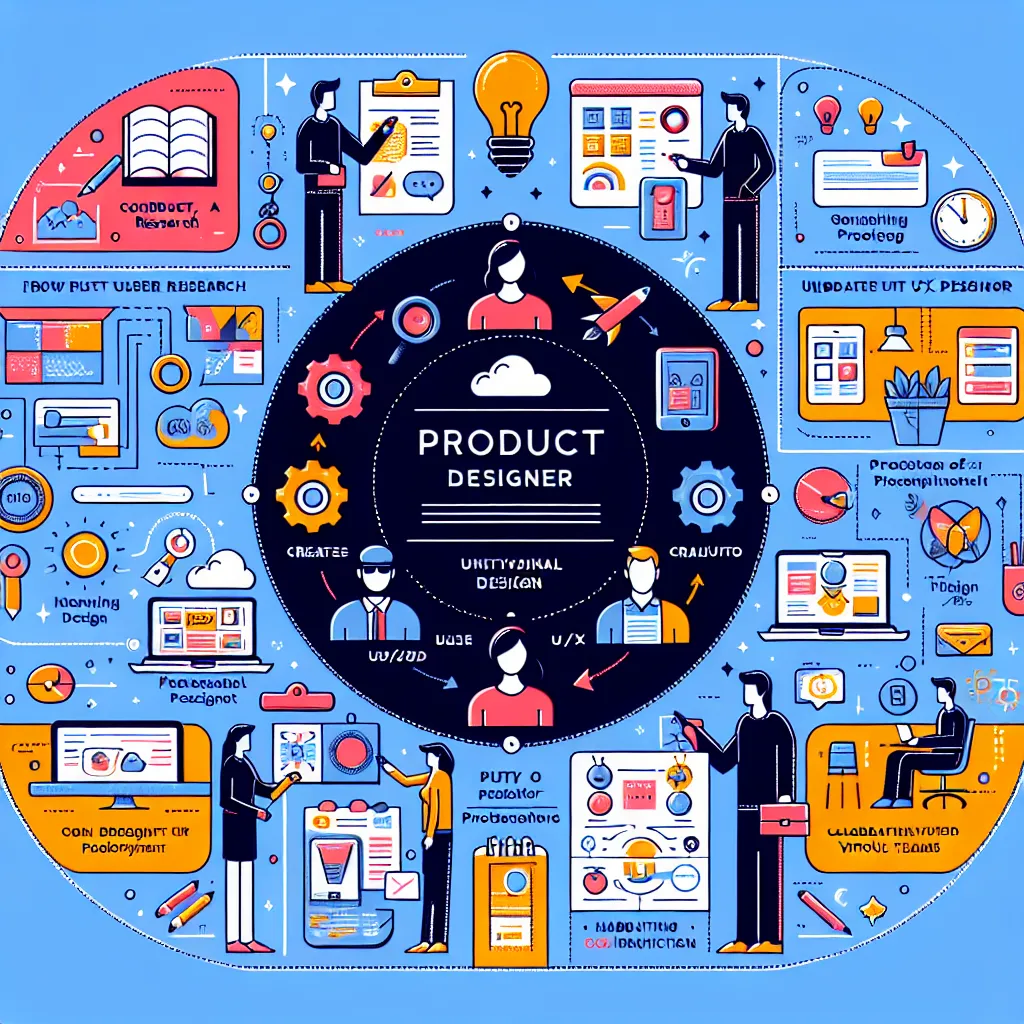Are you gearing up for a product designer interview? Whether you’re a seasoned professional or just starting your career, preparing for an interview in this field requires a unique blend of creativity, technical knowledge, and effective communication skills. In this comprehensive guide, we’ll walk you through the essential steps to help you ace your product designer interview.
Understanding the Role of a Product Designer
Before diving into interview preparation, it’s crucial to understand what a product designer does. Product designers are responsible for creating innovative and user-friendly products that meet both user needs and business objectives. They play a pivotal role in the product development process, from conceptualization to final implementation.
Key Responsibilities of a Product Designer
- User Research: Conducting user interviews and surveys to understand user needs and pain points.
- Ideation: Generating creative solutions to address user problems.
- Prototyping: Creating low and high-fidelity prototypes to test and refine ideas.
- User Interface (UI) Design: Designing visually appealing and intuitive interfaces.
- User Experience (UX) Design: Ensuring smooth and enjoyable user interactions with the product.
- Collaboration: Working closely with cross-functional teams, including developers, product managers, and marketers.
Understanding these responsibilities will help you tailor your preparation and showcase your skills effectively during the interview.
 Product Designer Responsibilities
Product Designer Responsibilities
Preparing Your Portfolio
Your portfolio is your most powerful tool in a product designer interview. It’s a showcase of your skills, creativity, and problem-solving abilities. Here’s how to make your portfolio stand out:
- Curate Your Best Work: Select 3-5 projects that best represent your skills and align with the company’s focus.
- Tell a Story: For each project, explain the problem, your process, and the final solution.
- Highlight Your Impact: Include metrics or user feedback that demonstrate the success of your designs.
- Show Variety: Include different types of projects to showcase your versatility.
- Keep It Up-to-Date: Regularly update your portfolio with your latest and best work.
Remember, quality trumps quantity. It’s better to have a few well-presented projects than a large number of mediocre ones.
Brushing Up on Technical Skills
Product design interviews often include technical questions to assess your knowledge and skills. Here are some areas to focus on:
- Design Tools: Be proficient in industry-standard tools like Sketch, Figma, or Adobe XD.
- UX Principles: Understand key concepts like user-centered design, information architecture, and usability testing.
- UI Design: Know the principles of visual design, color theory, and typography.
- Prototyping: Be able to create interactive prototypes using tools like InVision or Principle.
- Design Systems: Understand how to create and work with design systems.
It’s also beneficial to stay updated on the latest design trends and technologies in the field.
Preparing for Common Interview Questions
While each interview is unique, there are some common questions you can expect. Here are a few examples with tips on how to answer them:
1. “Can you walk us through your design process?”
This question aims to understand how you approach problem-solving. Describe your process step-by-step, from research to final implementation. Use a specific project example to illustrate your points.
Example Answer: “My design process typically starts with thorough user research. For instance, in my last project for a fitness app, I began by conducting user interviews and surveys to understand the pain points of fitness enthusiasts. Based on these insights, I created user personas and journey maps. Next, I moved to the ideation phase, where I conducted brainstorming sessions with the team and sketched out multiple solutions. We then narrowed down to the most promising ideas and created low-fidelity wireframes. After iterating based on user feedback, we developed high-fidelity prototypes and conducted usability testing. Finally, I worked closely with developers to ensure the design was implemented accurately.”
2. “How do you handle feedback and criticism on your designs?”
This question assesses your ability to collaborate and your openness to improvement.
Example Answer: “I view feedback as an essential part of the design process. It helps me see blind spots and improve my work. When receiving feedback, I listen actively and ask clarifying questions to fully understand the perspective. I try to detach myself emotionally from the design and focus on how the feedback can make the product better for the users. For instance, in a recent project, a stakeholder suggested a major change to the navigation structure. Instead of getting defensive, I asked for more details about their concerns, conducted additional user testing, and ultimately found a solution that addressed both the stakeholder’s concerns and user needs.”
3. “How do you stay updated with the latest design trends and technologies?”
This question aims to gauge your passion for the field and your commitment to continuous learning.
Example Answer: “I’m passionate about staying at the forefront of design trends and technologies. I regularly follow design blogs and publications like A List Apart and Smashing Magazine. I’m also active in online design communities like Dribbble and Behance, where I draw inspiration from fellow designers. Additionally, I attend design conferences and workshops when possible. For example, I recently attended a workshop on designing for voice interfaces, which has been incredibly helpful in my current project involving smart home devices.”
4. “Can you describe a time when you had to make a difficult design decision?”
This question assesses your decision-making skills and how you balance different factors in your design process.
Example Answer: “In a recent e-commerce project, we were redesigning the checkout process. Our data showed that adding a guest checkout option could increase conversions, but the marketing team was pushing for mandatory account creation to gather more customer data. It was a challenging situation as both sides had valid points. To resolve this, I conducted A/B testing with both versions. The results showed a 15% increase in conversions with the guest checkout option. I presented these findings to the stakeholders, explaining how the increased conversions would ultimately lead to more customer data in the long run. This data-driven approach helped convince the marketing team, and we implemented the guest checkout option.”
5. “How do you ensure your designs are accessible to all users?”
This question evaluates your understanding of inclusive design principles and your commitment to creating products that serve all users.
Example Answer: “Accessibility is a crucial aspect of my design process. I always strive to create designs that are usable by people with a wide range of abilities. This includes following WCAG guidelines, ensuring proper color contrast, designing for keyboard navigation, and providing alternative text for images. In a recent project for a banking app, we conducted usability testing with users who have various disabilities. This helped us identify and address several accessibility issues, such as improving screen reader compatibility and adjusting touch target sizes for users with motor impairments. I believe that designing for accessibility not only helps users with disabilities but often improves the experience for all users.”
Common Mistakes to Avoid in Product Designer Interviews
While preparing for your interview, it’s equally important to be aware of common pitfalls. Here are some mistakes to avoid:
-
Focusing Only on Aesthetics: While visual appeal is important, don’t neglect to discuss the reasoning behind your design decisions and how they solve user problems.
-
Ignoring Business Goals: Remember that good design aligns with business objectives. Be prepared to discuss how your designs can impact key business metrics.
-
Not Asking Questions: Failing to ask thoughtful questions about the role or company can make you appear disinterested. Prepare a list of relevant questions to ask your interviewers.
-
Overlooking Research and Data: Don’t present design solutions without explaining the research and data that informed your decisions.
-
Being Unprepared for Technical Questions: While creativity is crucial, product design also involves technical knowledge. Be ready to discuss your proficiency with design tools and methodologies.
-
Neglecting to Show Your Process: Employers are often more interested in your thought process than the final product. Be prepared to walk through your design process in detail.
-
Not Tailoring Your Portfolio: Failing to customize your portfolio for the specific role or company you’re interviewing with can be a missed opportunity to show your relevance and enthusiasm.
Follow-up Interview Questions and How to Answer Them
After your initial interview, you might be called back for a follow-up. Here are some questions you might encounter in a second interview, along with tips on how to answer them:
- “Based on what you’ve learned about our product, what would you change or improve?”
Tip: This is your chance to show that you’ve done your homework. Provide thoughtful, constructive feedback based on user needs and business goals.
- “Can you walk us through a design challenge you might face in this role and how you’d approach it?”
Tip: Use this opportunity to demonstrate your problem-solving skills and your understanding of the company’s specific challenges.
- “How would you handle a situation where the development team says your design is too complex to implement within the given timeframe?”
Tip: Show your ability to collaborate and compromise. Discuss how you’d work with the team to find a solution that balances design ideals with technical constraints.
- “If you were to join our team, what would your first 30 days look like?”
Tip: Outline a plan that shows your ability to quickly integrate into the team and start contributing. Include steps like understanding the product, getting to know the team, and identifying quick wins.
- “How do you measure the success of your designs?”
Tip: Discuss both qualitative and quantitative metrics. Show that you understand the importance of data-driven design decisions.
Conclusion
Preparing for a product designer interview requires a combination of portfolio preparation, technical skill review, and practice answering common questions. Remember to showcase not just your design skills, but also your problem-solving abilities, collaboration skills, and understanding of business objectives.
As you prepare, consider reviewing more resources on interview preparation. Our article on how to prepare for a UX designer interview offers additional insights that could be valuable for product designers as well. Additionally, understanding how to describe your work ethic in an interview can help you convey your professional values effectively.
Remember, the key to a successful interview is not just in having the right answers, but in demonstrating your passion for design and your ability to create products that truly meet user needs. Good luck with your interview!




